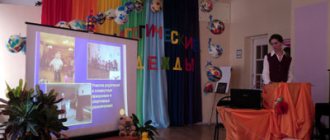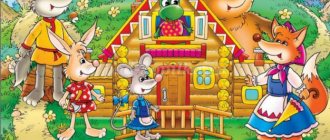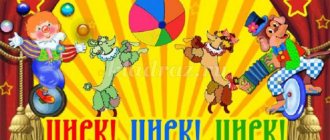"Visiting Clouds and Droplets"
GBOU secondary school No. 1317 (preschool department)
Summary of educational and research activities in the middle group
Theme: “Visiting Clouds and Droplets.”
Prepared and conducted by: teacher of group No. 12 Stolyarova Marina Ivanovna
Moscow 2014 -2015 academic year
Target:
Systematize children's knowledge about the properties of air and water through the organization of joint activities.
Objectives:
• Developmental: develop observation, curiosity, thinking, memory, speech, cognitive activity. • Educational: expand children’s horizons about air and water, their properties, using experiences and experiments (educational area - cognition). Develop free communication with adults and peers in the process of conducting experiments, enrich children's vocabulary (speech area). Strengthen interaction skills in a team, in a group (social-communicative area), form initial knowledge about a healthy lifestyle (physical development). • Educational: to cultivate a positive attitude towards the world around us, interest in cognitive activity, independence.
Preliminary work:
games “Blowers”, “Balloon”, “Stream”, “Sinking or not sinking”, reading fiction, making boats and fans. Making clouds and droplets.
Materials and equipment:
plastic bags, cups, cocktail tubes, soap bubbles, flags, Kinder Surprise toys, gouache paint (different colors), brushes, lemon, sugar, salt, molds, aprons. Layouts: cloud and droplet.
Progress of educational activities:
Organizational moment “guess”.
Educator:
Attention! Attention! Miracles are coming. It will be interesting here! Guess the riddle, Who will she find out about:
There was a gray blanket in the sky, a storm blanket, sank low and low and hung over the city. Thunder is already roaring, Lightning is sparkling in it. The clouds gathered in a heap, became a thundercloud... ( cloud
). (N. Shemyakina)
Showing the model of the cloud.
Tuchka:
Hello guys!
I walked through the sky and ended up in your kindergarten. While I was floating across the sky, I had some questions in store for you. Oh, tell me, friends: will you answer them? Children:
Yes!
Cloud:
The first question is a riddle: We need him to breathe, to inflate the balloon. He’s next to us every hour, but we don’t see him.
( Air
)
Children's answers. Tuchka:
Guys, you often hear this word.
Do you know what it means? Children's answers. Tuchka:
Are you interested in finding out where you can find air?
Children:
Yes.
Tuchka:
Get ready to listen carefully, I’ll tell you everything now!
Educator
: Tuchka, let’s not only tell the kids, but also show them - I invite everyone to our laboratory, where you will do experiments like real scientists.
What is a laboratory? Children's answers. Educator
: That's right, this is a room where various experiments are carried out. All employees of our laboratory must follow a number of rules: Rule No. 1. Do not touch anything on the tables without permission. Rule #2. Maintain silence and do not disturb other children. Rule #3. Do not taste the contents of the vessels without permission. Rule #4. Handle the equipment with care. Once done, put it back in its place. Rule #5. Remember - some experiments can only be carried out in the presence of adults.
Children approach the tables.
Tuchka:
Tell me guys, do you see the air around us?
Children's answers. Tuchka:
If we don’t see him, what is he like?
Children's answers. Educator:
That's right, the air is transparent - invisible - colorless.
Cloud:
Almost invisible, that means he’s not there at all, right?
Children's answers.
Cloud:
We don’t see air, but it is around us.
Educator:
Guys, let's prove that there is air, to do this you need to catch it.
Take plastic bags. Calmly draw air through your nose and slowly inhale it into the bag, then wrap it to prevent it from deflating. What was the package like? Children's answers. Educator:
Why did he become like this?
What filled the bag? Children's answers. Educator:
Of course, you filled the bag with air.
Educator:
Boys, take the flags, and the girls take the fans and wave them.
What do you feel? Children's answers. Tuchka:
So we have proven that although we don’t see air, it is around us.
Air can take different forms. Try blowing soap bubbles. What did you notice? Children's answers. Educator:
That's right, some bubbles are big, others are small.
Children's answers. Cloud:
All bubbles are different, which means the air takes different shapes!
And yet, the air is very light. Educator:
There are glasses of water with straws in front of you - blow into the straws.
What's happening? Children's answers. Educator:
The bubbles formed are air.
It rises to the surface of the water because... it's light. Cloud:
Guys, does the air have a smell?
Children's answers. Educator:
You have a lemon on the table.
Smell it. What can we say? Children's answers. Tuchka:
That’s right, lemon smells
-
we can conclude that the smell is transmitted through the air.
Educator:
I have a surprise for you.
Look how big my piece of plastic film is. What is she like? Light, airy, obedient to the air. Do you know who parachutists are? And what opens up above their heads when they jump from a plane? Children's answers. Educator:
Let's make a parachute too. And, of course, air will help us with this.
Physical exercise:
Game with air “Parachute”.
Together we all stood in a circle (stand up)
We will make a parachute
(they grab the film)
We walk one after another We carry the parachute in our hands
(they walk in a circle)
We raise our hands up
(raise our hands)
We inflate our parachute.
This is our parachute, inflated with light air (lowered to the floor). Educator:
Did we have a good time playing with the air?
Did you like it? Tuchka:
You played well with the air, but what do you remember about it?
Children's answers.
Educator: Well done guys, you correctly remembered that: - there is air everywhere around us; - you and I breathe air; - air is invisible, but it can be found in different ways; - the air is light; - smell is transmitted through the air; - you can play with air.
A droplet appears from behind a cloud.
Showing the droplet layout.
Drop:
Hello boys and girls!
You learned a lot about air, but did they tell you about wire? Children's answers.
Educator: Droplet, hello!
You can tell us about the properties of water and even conduct experiments with our guys. Droplet:
Guys!
Do you know how to behave when conducting experiments? Children's answers.
Droplet: Well done!
Remember all the rules, then let's get started. You have water in your glass - taste it. What is she like? Children's answers.
Educator: Add salt to one glass, sugar to another and stir.
Try, what did the water become? Children's answers.
Educator: That's right, where salt is added, the water is salty. And where sugar is added, it’s sweet. This means that water can change its taste.
Drop:
And not only taste, but also color.
Now we will prove it. Put a toy in a glass, can you see it? So what kind of water is it? Children's answers.
Educator: Now, using a brush, add paint to the water.
What did you notice? Children's answers.
Educator: That’s right, your water has become multi-colored.
Droplet:
We conclude that the water changes color.
Educator:
Let's continue our experiments.
There are molds in front of you - carefully pour water into them. Droplet:
Everyone’s molds are different, which means the water can take different shapes.
Educator:
Guys, did you like the experiments with water?
What can water change? Children's answers.
Droplet: That's right, water can change taste, color and shape.
But these are not all the properties of water. Tuchka:
And not all the properties of air.
If you want, we can come to visit you another time and conduct more experiments with you? Children's answers.
Surprise moment. Drop:
And as a parting gift, we want to give you gifts.
I am these paper boats that you can decorate and launch in the spring streams. Cloud:
And I have these balloons that you can inflate and launch into the blue sky.
Educator:
Let's guys thank the cloud and the droplet and say goodbye to them until we meet again.
Literature
1. Veraksa N. E., Galimov O. R. “Cognitive and research activities of preschool children” Publisher: Mozaika-Sintez, 2014
2.N. V. Nishcheva. “Cognitive and research activity as a direction for the development of a preschooler’s personality” (Experiments, experiments, games) Publisher: Detstvo-Press, 2013
Internet resources
1. allforchildren.ru



